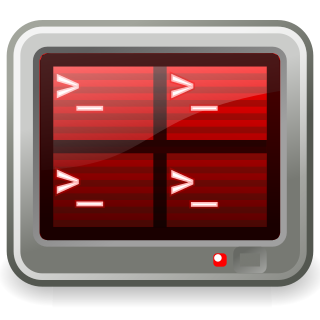Top Qs
Timeline
Chat
Perspective
GNOME Terminator
Terminal emulator influenced by GNOME Terminal From Wikipedia, the free encyclopedia
Remove ads
GNOME Terminator is a free and open-source terminal emulator for Linux programmed in Python, licensed under GPL-2.0-only. The goal of the project is to produce a useful tool for arranging terminals. It is inspired by programs such as gnome-multi-term, QuadKonsole, etc. In that the main focus is arranging terminals in grids (tabs is the most common default method, which Terminator also supports). Terminator packages exist for Arch,[2] Debian/Ubuntu,[3] Fedora,[4] OpenSUSE,[5] Gentoo,[6] Snap,[7] FreeBSD,[8] OpenBSD.[9] In 2017 took second place in voting at opensource.com, after Gnome Terminal.[10]
This article has multiple issues. Please help improve it or discuss these issues on the talk page. (Learn how and when to remove these messages)
|



Remove ads
History
Terminator is not a fork of GNOME Terminal (which is written in C); instead, it was developed from scratch by Chris Jones, entirely in Python (based on PyGObject to interact with the desktop environment and Python VTE providing the GUI component), but much of the behavior of Terminator is based on GNOME Terminal.[11] Terminator began from vte-demo.py in VTE and the gedit terminal plugin, which was useful to the authors for figuring out VTE's API.
In July 2013, Steve Boddy succeeded Jones and took the lead of the project.
GTK3+ support started near the end of 2012. The first version supporting GTK3+ was published by the end of 2016.
In April 2020 the project was forked to GitHub due to a lack of activity on Launchpad.[12][13]
Remove ads
Features
The following features are available in the 2.x release of Terminator.[14]
- Arrange terminals in a grid-like structure[15][16][17]
- Tabs[18]
- Drag and drop re-ordering of terminals
- Lots of keyboard shortcuts[19]
- Save multiple layouts and profiles via GUI preferences editor
- Simultaneous typing to arbitrary groups of terminals
- Ability to hide a scrollbar[20]
- Extensible through plugins
References
Wikiwand - on
Seamless Wikipedia browsing. On steroids.
Remove ads


